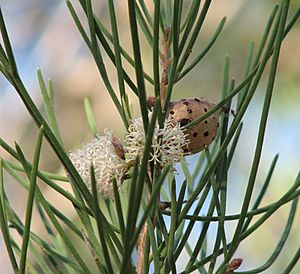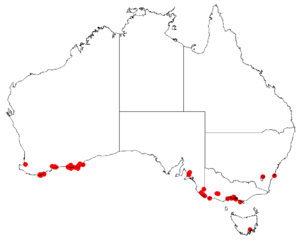Sweet scented hakea facts for kids
Quick facts for kids Sweet hakea |
|
|---|---|
 |
|
| Scientific classification | |
| Genus: |
Hakea
|
| Species: |
drupacea
|
 |
|
| Occurrence data from AVH | |
Hakea drupacea, also known as sweet scented hakea, is a type of tree or shrub. It grows naturally in the south west of Western Australia.
Contents
What is Sweet Hakea?
Sweet hakea is an upright, rounded shrub that usually grows to be 1 to 4 meters (about 3 to 13 feet) tall. Its smaller branches are a bit hairy.
Leaves and Flowers
The leaves of the sweet hakea are smooth and look like needles. They grow one after another along the stem, measuring 4 to 11 centimeters (about 1.5 to 4 inches) long and 1 to 2 millimeters (less than an inch) wide. Each leaf ends in a sharp point. Sometimes, a leaf might even split into 2 to 8 smaller parts.
This plant has short clusters of sweet-smelling flowers. They are white or cream-colored, often with pink or brownish tips from their pollen. These flowers appear in large numbers from March to June, growing where the leaves join the stem.
Fruit of the Sweet Hakea
After flowering, the sweet hakea produces woody, egg-shaped fruits. These fruits are about 20 to 25 millimeters (about 0.8 to 1 inch) long and 15 to 19 millimeters (about 0.6 to 0.75 inches) wide. Their surface is smooth, with a few black bumps. Each fruit also has two noticeable horns that are 2 to 4 millimeters long.
Where Does Sweet Hakea Grow?
Sweet hakea is mostly found along the coast of Western Australia. It grows between the city of Albany and areas east of Cape Arid, as well as on the islands of the Recherche Archipelago.
This plant has also started growing in other parts of the world where it wasn't originally found. This includes South Africa, New Zealand, and coastal Victoria in Australia. In South Africa, it's known as soethakea, which means "sweet hakea."
Sweet hakea prefers to grow in open areas with low shrubs or heathland. It can often be found on granite hillsides, or sometimes in areas with quartzite rocks or along coastal limestone cliffs.
Is Sweet Hakea Endangered?
The Western Australian Government's Department of Parks and Wildlife has classified Hakea drupacea as "not threatened." This means it is not currently at risk of disappearing.

